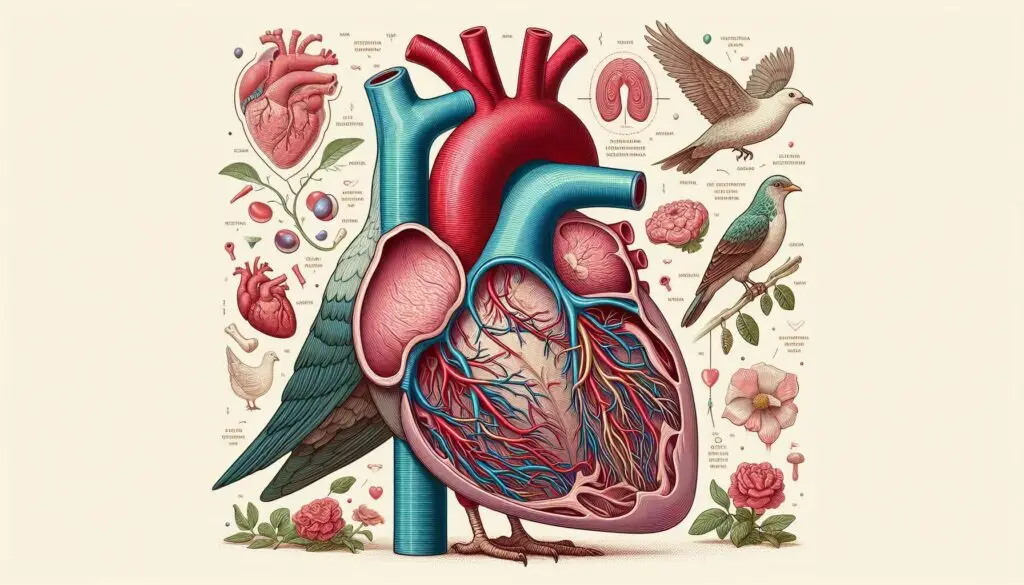The Avian Heart: Bird Cardiovascular Physiology

Structure of the Avian Heart
Birds possess a four-chambered heart, which includes two atria and two ventricles. This design is crucial for maintaining efficient blood circulation. The chambers are structured as follows:
- Right Atrium: Receives deoxygenated blood from the body.
- Right Ventricle: Pumps deoxygenated blood to the lungs.
- Left Atrium: Receives oxygenated blood from the lungs.
- Left Ventricle: Pumps oxygenated blood to the rest of the body.
Comparison with Mammalian Hearts
The avian heart is similar to mammalian hearts but has distinct differences. For instance, bird hearts are larger relative to body size compared to mammalian hearts. A human heart typically weighs about 0.4% of body weight, while a bird’s heart can weigh up to 4% of its body weight. This larger size is essential for meeting the high energy demands associated with flight.
Heart Size Variation Among Species
Different bird species exhibit variations in heart size and structure based on their lifestyles. Smaller birds often have proportionately larger hearts than larger birds. For example, hummingbirds have exceptionally large hearts relative to their body mass due to their energy-intensive hovering flight.
Function of the Avian Heart
The primary role of the avian heart is to pump blood throughout the body, delivering oxygen and nutrients while removing waste products. The efficiency of this process is vital for sustaining high metabolic rates.
Cardiac Output and Heart Rate
Birds generally have a higher cardiac output than mammals of similar size. Cardiac output refers to the amount of blood pumped by the heart per minute. It is influenced by both heart rate and stroke volume:
- Heart Rate (HR): The number of beats per minute.
- Stroke Volume (SV): The amount of blood pumped with each beat.
In birds, cardiac output can be expressed with the formula:
Q=HR×SV
Q=HR×SV
Where
Q
Q represents cardiac output.
Active vs. Resting States
Birds can significantly increase their cardiac output during activity by raising their heart rate. For instance, a resting pigeon may have a heart rate around 150 beats per minute but can reach over 500 beats per minute during flight.
Unique Adaptations for Flight
Birds have developed several adaptations that enhance their cardiovascular efficiency:
Larger Stroke Volume
Birds typically have a larger stroke volume compared to mammals. This means they can pump more blood with each contraction, which is crucial for meeting oxygen demands during flight.
Enhanced Blood Flow
The avian circulatory system features more pulmonary veins than mammals, allowing for efficient oxygen uptake in the lungs. This adaptation ensures that birds can quickly replenish oxygen levels in their blood.
Rapid Electrical Conduction
The conducting system of a bird’s heart is specialized for rapid electrical conduction. This system includes:
- Sinoatrial Node: Acts as the primary pacemaker.
- Auriculoventricular Node: Connects atria and ventricles.
- Purkinje Fibers: Distribute electrical impulses throughout the ventricles.
These specialized structures enable quick contractions necessary for high-energy activities like flying.
Physiological Measurements and Relationships
Research has established several important relationships regarding avian cardiovascular physiology:
Heart Mass and Body Size
Heart mass in birds relates closely to body mass. The equation representing this relationship is:
HM=8.76×M0.92
HM=8.76×M
0.92
Where
HM
HM is heart mass in grams and
M
M is body mass in kilograms.
Heart Rate and Body Size
Similarly, heart rate also correlates with body size:
HR=178.5×M−0.282
HR=178.5×M
−0.282
This indicates that smaller birds tend to have higher heart rates than larger ones.
Cardiac Output and Oxygen Consumption
Cardiac output also directly relates to oxygen consumption:
Q=17.5×VO21.04
Q=17.5×VO
2
1.04
Where
VO2
VO
2
represents oxygen consumption in milliliters per minute.
Implications for Bird Behavior and Ecology
The unique physiology of bird hearts has significant implications for their behavior and ecology:
Energy Expenditure During Flight
Birds expend considerable energy during flight, requiring efficient cardiovascular systems to sustain this activity. Their ability to quickly adjust heart rates allows them to respond effectively to varying energy demands.
Adaptations for High Altitude Flight
Some birds, like the bar-headed goose, have adapted to fly at high altitudes where oxygen levels are low. Their cardiovascular systems are specially adapted to maximize oxygen uptake under these conditions.
Conclusion
The avian heart exemplifies remarkable evolutionary adaptations that support high metabolic demands associated with flight. Its four-chambered structure ensures efficient separation of oxygenated and deoxygenated blood, while specialized features enhance cardiac output and stroke volume. Understanding these physiological aspects provides valuable insights into how birds thrive in diverse environments.
For more pearls of Vets Wisdom:
https://wiseias.com/partitioning-of-food-energy-within-animals/






Responses